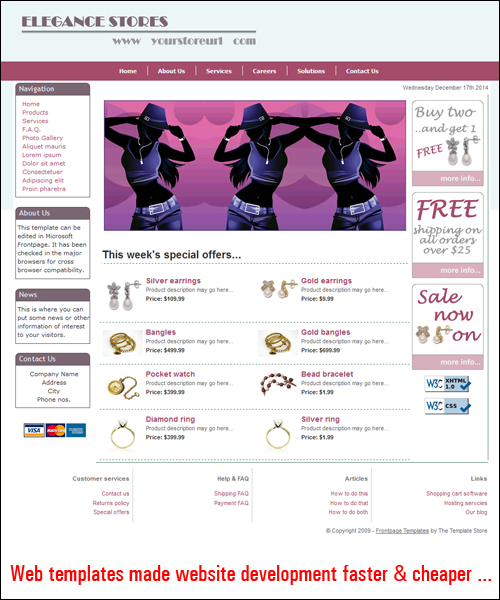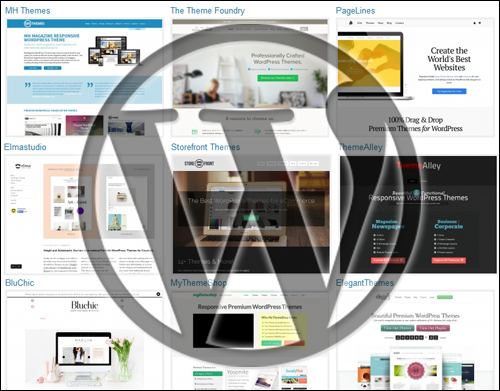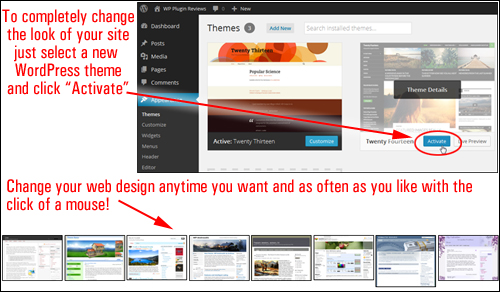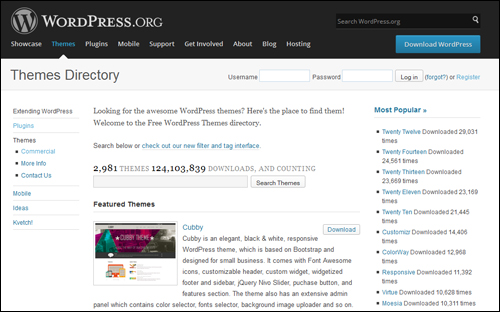 Advanced web site management platforms like the WordPress Content Management System (CMS) have effectively improved web design and web development for business owners.
Advanced web site management platforms like the WordPress Content Management System (CMS) have effectively improved web design and web development for business owners.
This is a great thing for business owners planning to start or build a website that they can easily manage by themselves.
Prior to “blogging” and the introduction of advanced content management systems, if you needed a business web site, you typically would have to wait until both the website development and web design processes were completely done. This process could mean weeks, sometimes even many months of waiting for the work to be done!
WordPress themes changed all this. In this post, we explore what WordPress themes are, how WordPress themes save your business money on website development costs, and how themes help you easily customize your website.
Website Design Evolution
More website owners today are benefiting from an evolution in web design that started several years ago. If you own a business, you may want to learn more about this, because it can save you a lot of time and money on website development or web design costs.
Very briefly, here’s what happened before software like WordPress were introduced:
First, you would meet with a website developer or website designer for a brief. Next, the design would be decided upon. This involved time being spent with someone with web design skills discussing things of the web site such as the layout, colors, formats, graphic elements, content, etc.
Every page of your website then had to be hand-coded with all of the elements and scripts coded into the page content. All pages were then assembled together into a web site using links and custom coded navigation menus and uploaded to your server, along with all other files needed to make your site work – script libraries, graphic images, media, etc.

(image source:adobe.com)
Only after everything had been tested and worked how it was supposed to (and looking the way the client had wanted it to look), was the site deemed as being completed and ready to go live.
Then, web design “templates” were introduced”. Web templates allow the ”look and feel” of the website to be created separately from the page content. Having templates helped speed up the process of developing web sites and resulted in lowered production costs. This also enabled web site development firms to service business clients and clients with smaller marketing budgets …

(image source: www.dreamweaver-templates.org)
As more businesses started adopting “template-based” websites, templates started being introduced that offered clients with expanding customizable features and options, such as color palettes, the ability to specify different styles or header, footer and navigation elements, and so on.
As websites and website editing applications evolved, web templates also began to transform into web template “systems” that permitted website owners and web designers to manage the design aspects of a website.
Then, WordPress came along and helped to kick off a new website revolution …

(WordPress – A Content Publishing Revolution)
To learn more about content management systems and the benefits of the WordPress CMS, see the tutorial below:
The WordPress Theme
A WordPress theme drives the idea of a web templating system one step further.
The WordPress theme system controls and unifies the design areas of the web site. It lets you add a “skin” to your site much like a template system does but also provides you with more control over the management and ability to customize all template settings.
As explained in the official WordPress site …
A WordPress Theme is a collection of files that work together to produce a graphical interface with an underlying unifying design for a weblog. These files are called template files. A Theme modifies the way the site is displayed, without modifying the underlying software. Themes may include customized template files, image files (*.jpg, *.gif), style sheets (*.css), custom Pages, as well as any necessary code files (*.php).
(source: WordPress.org)
As stated in the quote above, a unique feature of a WordPress theme is that how your site displays to visitors externally in no way affects your site’s content management settings.
Basically, what this means is that WP themes let you change the design of your site as often as you want without affecting your site’s content and all the work you’ve put into it. For example, if WP site has been set up for e-commerce, changing the entire look of your site with another theme won’t affect the content or the functionality of your website. All e-commerce features, plugin settings and product information will remain intact, but your site will look completely different.
This is important. Why?
Because when your site is built using WordPress, you no longer have to spend weeks or months waiting for your site to be done. You can get your business website built quickly and get started with any WP theme you like, and then edit the entire look, feel and design of your site in minutes, whenever you decide … and as often as you like!
Even better, you can easily install a theme on your WordPress site without the need of website code development skills. Just pick a WordPress theme you like, install it on your site and activate it. WordPress allows you to change your web design and modify elements like headers, page layout, style settings and more with just a few mouse clicks …

Since WordPress is distributed as open source software, thousands of website designers can create themes specifically for the WordPress platform using the WP template system.
This means that thousands of high quality WP themes are made available to WP users. WP are generally distributed for Free under the terms of the GNU License Definition, or sold as Premium (i.e. paid) WP themes.
The WordPress team keeps a FREE WordPress Theme Directory which gives WordPress users access thousands of great themes completely free of charge …

(WordPress.org – WP Themes Directory)
As the popularity of WordPress increases, more designers are now focusing on creating themes for a wider audience of WordPress users.
WP themes vary from bare-looking, to dynamic designs that are visually beautiful and would typically cost many hundreds of dollars to create. Surprisingly, most WP themes are fairly inexpensive to buy.
You can view a number of theme galleries containing many examples of great premium WordPress themes in this article:

(Browse Thousands Of FREE WordPress Themes!)
Themes – Benefits And Advantages
Here are just a few of the benefits of using WordPress themes over choosing applications that require traditional web design:
Easy And Quick To Install
Themes are quite easy to install on your site. Simply upload it to your Plugins folder via your WordPress dashboard and activate. Even easier still, you can install any of the themes listed in the WordPress themes repository at WordPress.org) directly inside your WordPress admin’s “Theme” section.

Additionally …
- WordPress has a thriving community of professional web developers and development companies who contribute thousands of quality WP Themes available to users. Thousands of these themes are completely free to use!
- Themes give sites a consistent “look and feel” across all the site’s elements, i.e. pages, headers, footers, menus, etc …
- A “theme” works independently of your blog’s content. This makes it possible to change WP themes as often as you need without changing your blog content.
- Many WP themes come with additional built-in features and settings that let you customize your theme’s style and design elements and create a unique look to suit your needs.
- Many themes are built using a framework that allows users to update the theme to a newer theme version without losing any unique customizations (e.g. styles)
- WordPress allows you to search, import and install WordPress Themes automatically right within your dashboard.
- WP themes lets you save hundreds of dollars on web development costs. Free WP themes cost nothing and most “Premium”themes are normally quite affordable.
Responsive WordPress Themes
Many theme developers are now developing “responsive” themes for WordPress.
A responsive theme enables a website to automatically reconfigure the layout to display smoothly over different screen sizes and resolutions, as well as different platforms) …

Responsive themes are also optimized for each platform. Users can scroll, read and display the site on different device platforms without having to readjust their browser settings, or requiring website owners to install additional browser elements.
Note: When purchasing WordPress themes, we strongly recommend choosing a responsive WordPress theme. Not only will the theme ensure that your website will work correctly across all of your visitors’ devices, it also means that the theme is newer than non-responsive themes and therefore complies with the latest standards of web design and web coding.
Hopefully, this basic overview has given you a clearer understanding about themes, what WordPress themes are, how themes can help you and your business save money on website design costs, and how themes make customizing sites easy.
In the next article in the article series for non-technical users on helping you understand features and functionality of WordPress, we show you where to find great WP themes for your website or blog.
***
"Your training is the best in the world! It is simple, yet detailed, direct, understandable, memorable, and complete." Andrea Adams, FinancialJourney.org
***